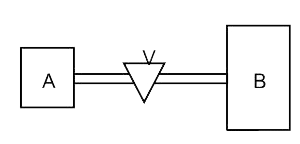Containers A and B have same gases. Pressure, volume and temperature of A are all twice that of B, then the ratio of number of molecules of A and B are
1:2
1:4
4:1
2:1
The correct Answer is:D
To solve the problem of finding the ratio of the number of molecules in containers A and B, we can follow these steps:
Step 1: Identify the Variables
Let:
- Pressure of container A = PA=2P
- Volume of container A = VA=2V
- Temperature of container A = TA=2T
For container B:
- Pressure of container B = PB=P
- Volume of container B = VB=V
- Temperature of container B = TB=T
Step 2: Use the Ideal Gas Law
The Ideal Gas Law is given by:
PV=nRT
Where:
- P = Pressure
- V = Volume
- n = Number of moles
- R = Universal gas constant
- T = Temperature
Step 3: Express the Number of Moles for Both Containers
Using the Ideal Gas Law, we can express the number of moles for both containers:
For container A:
nA=PAVARTA=(2P)(2V)R(2T)=4PV2RT=2PVRT
For container B:
nB=PBVBRTB=PVRT
Step 4: Find the Ratio of Number of Moles
Now, we can find the ratio of the number of moles nA to nB:
nAnB=2PVRTPVRT=2PVPV=2
Step 5: Relate Moles to Number of Molecules
The number of molecules N is related to the number of moles n by Avogadro's number NA:
N=n×NA
Thus, the ratio of the number of molecules in containers A and B is:
NANB=nA×NAnB×NA=nAnB=2
Step 6: Final Ratio
Therefore, the ratio of the number of molecules in containers A and B is:
NA:NB=2:1
Conclusion
The final answer is that the ratio of the number of molecules in container A to container B is 2:1.
---
Let:
- Pressure of container A = PA=2P
- Volume of container A = VA=2V
- Temperature of container A = TA=2T
- Pressure of container B = PB=P
- Volume of container B = VB=V
- Temperature of container B = TB=T
The Ideal Gas Law is given by:
PV=nRT
Where:
- P = Pressure
- V = Volume
- n = Number of moles
- R = Universal gas constant
- T = Temperature
Using the Ideal Gas Law, we can express the number of moles for both containers:
For container A:
nA=PAVARTA=(2P)(2V)R(2T)=4PV2RT=2PVRT
nB=PBVBRTB=PVRT
Now, we can find the ratio of the number of moles nA to nB:
nAnB=2PVRTPVRT=2PVPV=2
The number of molecules N is related to the number of moles n by Avogadro's number NA:
N=n×NA
Thus, the ratio of the number of molecules in containers A and B is:
NANB=nA×NAnB×NA=nAnB=2
Therefore, the ratio of the number of molecules in containers A and B is:
NA:NB=2:1
The final answer is that the ratio of the number of molecules in container A to container B is 2:1.
Similar Questions
The pressure P, Volume V and temperature T of a gas in the jar A and the other gas in the jar B at pressure 2P, volume V/4 and temperature 2T, then the ratio of the number of molecules in the jar A and B will be
View SolutionIf pressure and temperature of an ideal gas are doubled and volume is halved, the number of molecules of the gas
View Solution
Knowledge Check
- Question 1 - Select One
Two planets A and B have the same material density. If the radius of A is twice that of B, then the ratio of the escape velocity VA/VB is
A2B√2C1/√2D1/2 - Question 2 - Select One
The volume of vessel A is twice the volume of another vessel B and both of them are filled with the same gas. If the gas in A is at twice the temperature and twice the pressure in comparison to the gas in B, what is the ratio of number of gas molecule in A and B ?
A12B21C32D23
Two gases H2 and O2 fuse from two different containers having same pressure and temperature. If the ratio of area of cross section of hole is 1:2 then the ratio of rate of effusion will be
View SolutionTwo gases A and B having the same pressure P, volume V and temperature T are mixed. If mixture has volume and temperature as V and T respectively, then the pressure of the mixture will be
View SolutionSome ideal monoatomic gas A in an enclosure has a pressure P and the temperature T . Another ideal monoatomic gas B enclosed in a container of the same volume has a pressure of 2P and temperature T2. The ratio of the average kinetic energy per molecule of gas A to gas B is
View SolutionContainer A holds an ideal gas at a pressure 1×105 Pa and at 300 K. Container B whose volume is 4 times the volume of A has the same ideal gas at 400 K and at a pressure of 5×105

Before the valve V is opened, the ratio of number of moles of gas in A and B is :View SolutionWhich one of the following parts of gases contains the same number of molecules?
View SolutionConsider two containers A and B containing identical gases at the same pressure, volume and temperature. The gas in container A is compressed to half of its original volume isothermally while the gas is container B is compressed to half of its original vlue adiabatically. The ratio of final pressure of gas of B to that of gas in A is
View Solution

